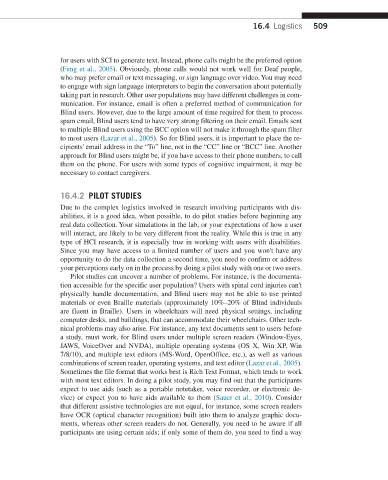Page 516 -
P. 516
16.4 Logistics 509
for users with SCI to generate text. Instead, phone calls might be the preferred option
(Feng et al., 2005). Obviously, phone calls would not work well for Deaf people,
who may prefer email or text messaging, or sign language over video. You may need
to engage with sign language interpreters to begin the conversation about potentially
taking part in research. Other user populations may have different challenges in com-
munication. For instance, email is often a preferred method of communication for
Blind users. However, due to the large amount of time required for them to process
spam email, Blind users tend to have very strong filtering on their email. Emails sent
to multiple Blind users using the BCC option will not make it through the spam filter
to most users (Lazar et al., 2005). So for Blind users, it is important to place the re-
cipients' email address in the “To” line, not in the “CC” line or “BCC” line. Another
approach for Blind users might be, if you have access to their phone numbers, to call
them on the phone. For users with some types of cognitive impairment, it may be
necessary to contact caregivers.
16.4.2 PILOT STUDIES
Due to the complex logistics involved in research involving participants with dis-
abilities, it is a good idea, when possible, to do pilot studies before beginning any
real data collection. Your simulations in the lab, or your expectations of how a user
will interact, are likely to be very different from the reality. While this is true in any
type of HCI research, it is especially true in working with users with disabilities.
Since you may have access to a limited number of users and you won't have any
opportunity to do the data collection a second time, you need to confirm or address
your perceptions early on in the process by doing a pilot study with one or two users.
Pilot studies can uncover a number of problems. For instance, is the documenta-
tion accessible for the specific user population? Users with spinal cord injuries can't
physically handle documentation, and Blind users may not be able to use printed
materials or even Braille materials (approximately 10%–20% of Blind individuals
are fluent in Braille). Users in wheelchairs will need physical settings, including
computer desks, and buildings, that can accommodate their wheelchairs. Other tech-
nical problems may also arise. For instance, any text documents sent to users before
a study, must work, for Blind users under multiple screen readers (Window-Eyes,
JAWS, VoiceOver and NVDA), multiple operating systems (OS X, Win XP, Win
7/8/10), and multiple text editors (MS-Word, OpenOffice, etc.), as well as various
combinations of screen reader, operating systems, and text editor (Lazar et al., 2005).
Sometimes the file format that works best is Rich Text Format, which tends to work
with most text editors. In doing a pilot study, you may find out that the participants
expect to use aids (such as a portable notetaker, voice recorder, or electronic de-
vice) or expect you to have aids available to them (Sauer et al., 2010). Consider
that different assistive technologies are not equal, for instance, some screen readers
have OCR (optical character recognition) built into them to analyze graphic docu-
ments, whereas other screen readers do not. Generally, you need to be aware if all
participants are using certain aids; if only some of them do, you need to find a way

